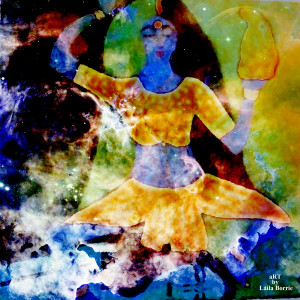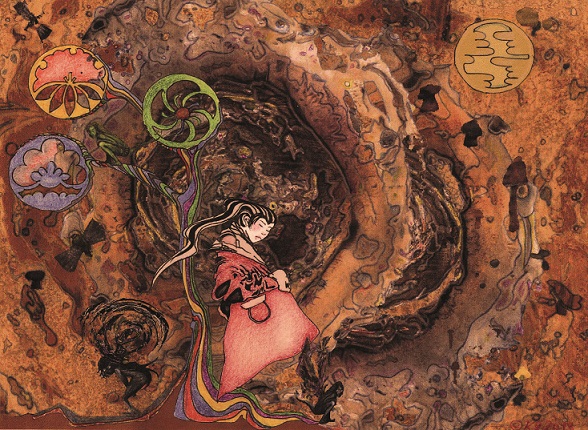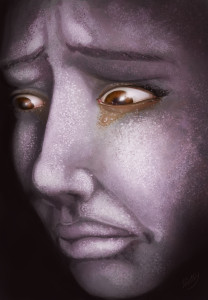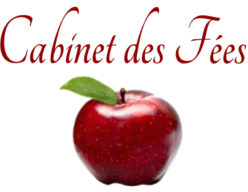Demeter’s Spicebox was always meant to be an interstitial project, a marriage between digital media and storytelling. We’ve had daydreams from the onset about comics, pictures and even short movies related to these stories. We’ve also received more than one email from artists asking if they could contribute art. So finally, we decided that it would be interesting to invite and challenge selected artists to share with us artwork that they thought represented stories with which they had connected the most. I chose artists whose art had depth, which corresponded to emotions or metaphors found in these stories. Each artist took a different approach to this challenge, which is about that connection between words and art. While it is lovely to have art that is made exclusively for a story, I was interested in what happens when a pre-existing story met a pre-existing work of art. Could there be an intersection between meaning in this context? Some artists felt that there could not be a convergence, primarily because both works should stand on their own — they made works of art for these stories from materials that they felt corresponded to the stories. Others found a resonance with their pre-existing works of art, albeit with modification. In short, the diversity of their artistic response speaks to the kind of heterogeneity we are trying to bring about with these stories and the intersecting artwork.
Demeter’s Spicebox’s first Volume has taken us from India, to the Far East, to the nations of the Silk Road, and though these lands may seem far-off and mysterious to many in the first world, to those of us who reside elsewhere, some of these cultures may feel comforting and familiar. But in fairy tales, even the everyday becomes a little strange, a little uncanny. You could step into a dream at any second, or into a painting. Something that already exists could be transformed into something new. We hope to have further artistic journeys such as this with future issues, but for now, I believe these works of art and the words of their artists speak for themselves!
Laila Borrie
 “I instantly fell in love with Shveta Thakrar’s Lavanya and Deepika because not only is it a fantastic fairy tale in every sense of the word but it also has an Indian theme and setting.The familiarity which comes from that is very comforting. Another aspect that I really appreciated is the fact that the princess gets the princess at the end! My painting titled ‘Shakti’ is about the balance of power between male and female. Shakti is considered to be power, creation and loving while her male counterpart is said to be a personification of silence, creativity and love. The interplay between these cosmic forces is what gives birth to the manifest universe. Yet we often see the feminine forms of life rejected and considered weaker in place of more masculine forms and energies.
“I instantly fell in love with Shveta Thakrar’s Lavanya and Deepika because not only is it a fantastic fairy tale in every sense of the word but it also has an Indian theme and setting.The familiarity which comes from that is very comforting. Another aspect that I really appreciated is the fact that the princess gets the princess at the end! My painting titled ‘Shakti’ is about the balance of power between male and female. Shakti is considered to be power, creation and loving while her male counterpart is said to be a personification of silence, creativity and love. The interplay between these cosmic forces is what gives birth to the manifest universe. Yet we often see the feminine forms of life rejected and considered weaker in place of more masculine forms and energies.
Lavanya and Deepika captures the essence of this beautifully and so I feel combines well with the energies and thought processes behind my painting.”
Laila Borrie was born and raised in Southern India. She moved to the Netherlands at the age of 26, supposedly for a ‘short period’. Eight years later, Laila is still calling Rotterdam home. Laila is passionate about mythology, folk-tales, the theater, philosophy, current affairs, gender based issues and art. She has recently begun a little company selling her art and assorted things of a whimsical nature. She is totally obsessed with colour and the range of emotions they inspire.
Kirsty Greenwood

“I adored Sister and Bones by Mari Ness, and immediately had an image in mind. Using several drawings I’d done with ink and paint I combined the illustrative parts, and then further drew over to pick out the elements of detail in the story that struck a chord with me: bark, gnarled skin, cherry blossom beauty, symbiotic magic and bargaining.
The central character of my illustration can be viewed as both the pregnant mother and the dutiful sister amongst the predator spirits of the forest. I had in mind a feeling of the Orient and used a simple graphic style to represent the cherry tree of life under which the girl stands, whilst the demons expectantly creep in the background’¦”
With the advantage of an illustrative mind-set, Kirsty Greenwood is motivated by ephemeral visual misunderstanding, transient half-light, ocular strangeness, nightmares, dreams and fleeting glimpses of unreality. Inspired by faerie tales, myths and legends, ailuroanthropy, science, Alice-syndrome and transformation, childhood memories, ghost stories, naiveté, music, antique cultures, the minds of other artists, Quixotism and true romanticism; her idiosyncratic work often has its roots in dreamlike non-realities to create art contained by the renovating of influences and ideas into images which often convey feelings of otherworldly states and a desire to know more of the subject. Favouring pencil and ink, mixing with photography and print,Greenwood likes to work intricately to produce detailed phantasmagorias and unusual scenarios or beings representing the worlds of both traditional and modern stories of all genres.
Kirsty lives in her native North Yorkshire and is heavily influenced by the rural Dales landscape she grew up in, literature, music and Art of all varieties. For further examples or to commission work please visit www.kirstygreenwood.co.uk
Stace Dumoski

“Salt. Even those of us who know the value of salt in the food we eat probably take for granted how easy it is to get to our kitchens and tables in this day and age. Just head to any grocery store or – if you favor more exotic varieties – place an order on the Internet to have the essential mineral delivered right to your door, in whatever quantities you might desire. But in ages past, salt wasn’t always so easy to come by (thus the superstition about spilling salt leading to bad luck) and I wanted to pay notice to that in this artwork.
The spilled salt on the left of the image could be a sample of the salt merchant’s wares, as he tries to persuade his customer to buy, in Joshua Gage’s story, Salt. And the wide salt flats on the right show the desert to which Kassa is exiled in The Salt of Aksum by Mae Epsum, surely a barren place to be the source of all her kingdom’s wealth! Or perhaps it is the inner landscape of wandering Suha’s broken heart.”
Stace Dumoski is a Content Marketer by day, aspiring Fantasy Writer by night. Her work has been published in Cabinet des Fees and A Fly in Amber, and at City-of-Bridges.com. You can view more of her artwork on her blog at http://www.dumoski.com.
Pictsy
 “Before reading the two short stories I was expecting a particular character or scene to stand out and spark inspiration for me to follow. I had no idea what either story was about. I was surprised on finishing Joshua Gage’s Salt that it would be something so simple as a tear that would provide the most poignant mental imagery for me. I really wanted to convey the theme of salt as well so I conceived of having a crying face covered in salt grains. When I read Mae Empson’s The Salt of Aksum, I was resolved to follow this idea further — it was clear that tears were one of the major common themes between the two. I was even more delighted that the second story justified my salt covered face idea with an almost identical description as what I had in mind. This concept excited me as it would give me an opportunity to express emotion through facial features and provide a challenge of making it appear as though the face is covered or made of salt. It was indeed a challenge to figure out how to get the texture looking grainy enough. In the end it was a very simple idea that provided the best solution – as is often the case in art.”
“Before reading the two short stories I was expecting a particular character or scene to stand out and spark inspiration for me to follow. I had no idea what either story was about. I was surprised on finishing Joshua Gage’s Salt that it would be something so simple as a tear that would provide the most poignant mental imagery for me. I really wanted to convey the theme of salt as well so I conceived of having a crying face covered in salt grains. When I read Mae Empson’s The Salt of Aksum, I was resolved to follow this idea further — it was clear that tears were one of the major common themes between the two. I was even more delighted that the second story justified my salt covered face idea with an almost identical description as what I had in mind. This concept excited me as it would give me an opportunity to express emotion through facial features and provide a challenge of making it appear as though the face is covered or made of salt. It was indeed a challenge to figure out how to get the texture looking grainy enough. In the end it was a very simple idea that provided the best solution – as is often the case in art.”
Pictsy is a UK-based visual artist and musician. She works in both the digital and traditional mediums, and is also interested in both photography and philosophical inquiry.
![]()
